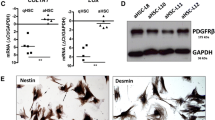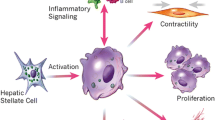Abstract
In vitro systems are required to evaluate potential liver fibrogenic effects of drugs and compounds during drug development and toxicity screening, respectively. Upon liver injury or toxicity, hepatic stellate cells are activated, thereby acquiring a myofibroblastic phenotype and participating in extracellular matrix deposition and liver fibrosis. The most widely used in vitro models to investigate liver fibrogenesis are primary cultures of hepatic stellate cells, which can be isolated from healthy human livers. Currently, there are no effective methods to maintain hepatic stellate cells in vitro in a quiescent phenotype. Therefore, when cells are plated, they spontaneously become activated in few days. Most in vitro studies in this area have been performed with monocultures of hepatic stellate cells in order to assess the direct effects of a given factor on hepatic stellate cell activation or the induction of inflammatory and fibrogenic responses. In this chapter, focus is put on basic protocols to isolate hepatic stellate cells from human tissue and to maintain them in culture as well as on common in vitro assays to evaluate their response to profibrogenic factors.
Access this chapter
Tax calculation will be finalised at checkout
Purchases are for personal use only
Similar content being viewed by others
References
Vinken M (2013) The adverse outcome pathway concept: a pragmatic tool in toxicology. Toxicology 4:158–165
Morales-Ibanez O, Dominguez M, Ki SH et al (2013) Human and experimental evidence supporting a role for osteopontin in alcoholic hepatitis. Hepatology 58:1742–1756
Mannaerts I, Eysackers N, Onyema OO et al (2013) Class II HDAC inhibition hampers hepatic stellate cell activation by induction of microRNA-29. PloS One 8:e55786
Friedman SL (2008) Hepatic stellate cells: protean, multifunctional, and enigmatic cells of the liver. Physiol Rev 88:125–172
Bataller R, Brenner DA (2005) Liver fibrosis. J Clin Invest 115:209–218
Mederacke I, Hsu CC, Troeger JS et al (2013) Fate tracing reveals hepatic stellate cells as dominant contributors to liver fibrosis independent of its aetiology. Nat Commun 4:2823
Troeger JS, Mederacke I, Gwak GY et al (2012) Deactivation of hepatic stellate cells during liver fibrosis resolution in mice. Gastroenterology 143:1073–1083
Friedman SL (2010) Evolving challenges in hepatic fibrosis. Nat Rev Gastroenterol Hepatol 7:425–436
Friedman SL (2004) Mechanisms of disease: mechanisms of hepatic fibrosis and therapeutic implications. Nat Clin Pract Gastroenterol Hepatol 1:98–105
Tsochatzis EA, Bosch J, Burroughs AK (2014) Liver cirrhosis. Lancet 383:1749–1761
Cardenas A, Gines P (2009) Portal hypertension. Curr Opin Gastroenterol 25:195–201
Sancho-Bru P, Bataller R, Gasull X et al (2005) Genomic and functional characterization of stellate cells isolated from human cirrhotic livers. J Hepatol 43:272–282
Xu L, Hui AY, Albanis E et al (2005) Human hepatic stellate cell lines, LX-1 and LX-2: new tools for analysis of hepatic fibrosis. Gut 54:142–151
Thomas RJ, Bhandari R, Barrett DA et al (2005) The effect of three-dimensional co-culture of hepatocytes and hepatic stellate cells on key hepatocyte functions in vitro. Cells Tissues Organs 181:67–79
Krause P, Saghatolislam F, Koenig S et al (2009) Maintaining hepatocyte differentiation in vitro through co-culture with hepatic stellate cells. In Vitro Cell Dev Biol Anim 45:205–212
Godoy P, Hewitt NJ, Albrecht U et al (2013) Recent advances in 2D and 3D in vitro systems using primary hepatocytes, alternative hepatocyte sources and non-parenchymal liver cells and their use in investigating mechanisms of hepatotoxicity, cell signaling and ADME. Arch Toxicol 87:1315–1530
Affo S, Morales-Ibanez O, Rodrigo-Torres D et al (2014) CCL20 mediates lipopolysaccharide induced liver injury and is a potential driver of inflammation and fibrosis in alcoholic hepatitis. Gut doi: 10.1136/gutjnl-2013-306098
Acknowledgements
This work was financially supported by grants from European Commission within its FP7 Cooperation Program and Cosmetics Europe (HeMiBio HEALTH F5 2010 number 266777). Pau Sancho-Bru and Mar Coll are funded by Instituto de Salud Carlos III and co-financed by Fondo Europeo de Desarrollo Regional (FEDER), Unión Europea, “Una manera de hacer Europa.”
Author information
Authors and Affiliations
Corresponding author
Editor information
Editors and Affiliations
Rights and permissions
Copyright information
© 2015 Springer Science+Business Media New York
About this protocol
Cite this protocol
Perea, L., Coll, M., Sancho-Bru, P. (2015). Assessment of Liver Fibrotic Insults In Vitro. In: Vinken, M., Rogiers, V. (eds) Protocols in In Vitro Hepatocyte Research. Methods in Molecular Biology, vol 1250. Humana Press, New York, NY. https://doi.org/10.1007/978-1-4939-2074-7_30
Download citation
DOI: https://doi.org/10.1007/978-1-4939-2074-7_30
Published:
Publisher Name: Humana Press, New York, NY
Print ISBN: 978-1-4939-2073-0
Online ISBN: 978-1-4939-2074-7
eBook Packages: Springer Protocols




